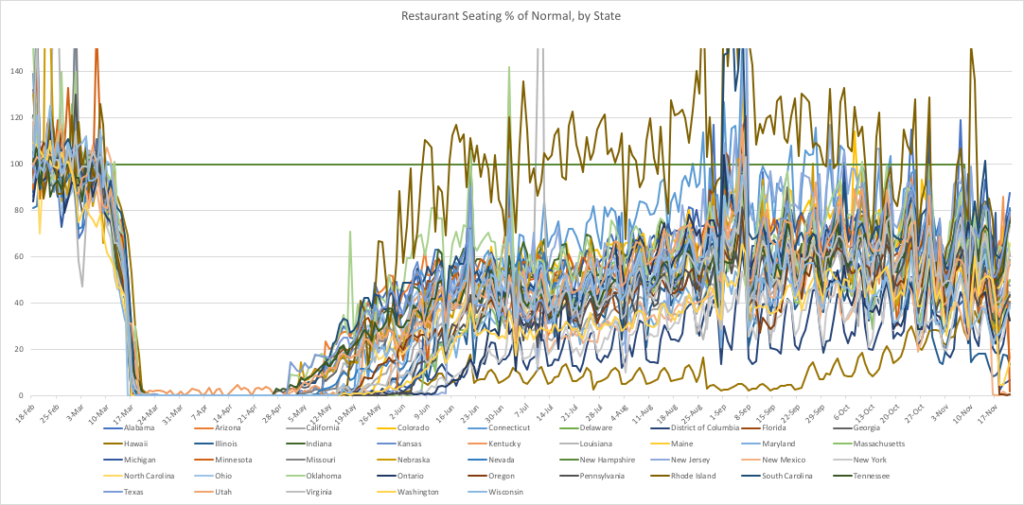
This chart shows new confirmed Covid-19 cases in each part of the US. A couple months ago things got bad in the Dakotas and surrounding states. Then it improved there, but got worse everywhere else. There was a sudden reverse last week. New cases declined in every region. It may be good news, but more likely it’s because health departments ended the week early.

This one shows weekly restaurant seatings from OpenTable, comparing this year to 2019. After the April/May shutdown, it rose gradually to about 60% of last year. Now it has declined back to about 35%. There’s a big spread between states: New York is at 12%, California 6%. Texas and Florida are still near 60%. I don’t know why everyone decided to eat out during Labor Day week.
Last July I divided the largest countries into 5 groups, and made charts for their cumulative confirmed Covid counts. Here are updated global CCCCCCs. All numbers are cases per 100,000 people.

First are the countries that were doing it right back then. Almost all of them are still doing it right. They have very few cases, and economies that are close to normal. The only exception is Tunisia. It’s starting to catch up with Europe.

Next are countries that were just starting to increase in July. Most of them halted the growth, but Jordan, Morocco and Greece are acting like Europe. Some of the poorer countries may have low counts from lack of testing, rather than lack of disease.

The third group is countries in Europe, plus Canada. They had serious early outbreaks, but contained the disease over the summer. Sadly, things got much worse once the weather cooled. Canada and Germany aren’t too bad, but the rest are doing almost as badly as the US.

The fourth group is countries that were just starting to have serious problems in July. They are a mixed bag now. Some are doing OK, but the ones in Europe and South America have growth rates similar to their neighbors.

The last group I called the “basket cases”, with outbreaks that were bad and getting worse. Those in the Southern Hemisphere slowed down as their summer hit. Those with disease-friendly politics became even more baskety. Portugal started zooming recently, similar to the rest of Europe.
The countries with the most per-capita Covid cases now are #1. Czechia, #2. Belgium, and #3. USA.
About 45% of the world population is in places where Covid-19 is no big deal: China, all of East Asia and Southeast Asia, Australia, New Zealand. A few island nations and isolated countries. When a disease is contained, it’s possible to keep it that way. Though it’s much harder when neighboring countries don’t have it under control.
About 5.5% of people in the US have been infected so far. Keep in mind that it takes roughly 80% to reach ‘herd immunity’. Take the pain of the past 10 months and multiply it by 15 to get there naturally. It’s why we need vaccines.
Dennis Kolva
Programming Director
TurtleSoft.com





